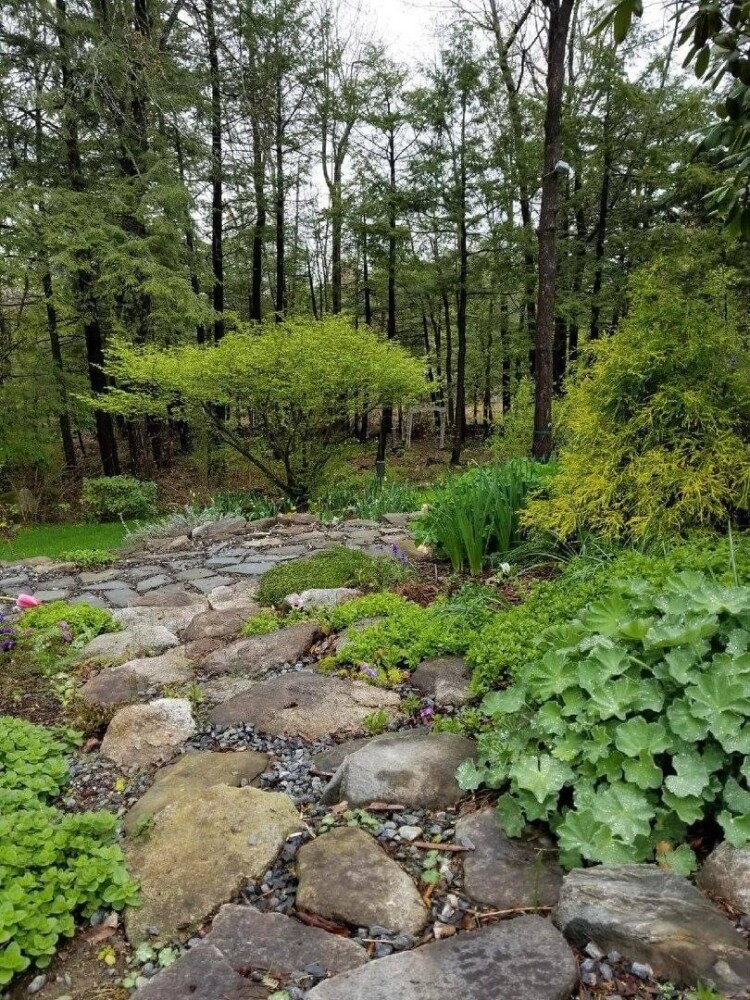The first job in designing a landscape project is creating the hardscape – such things as walls, stairs and paths.
Jason Allerding, proprietor of All Things Landscape and Stonework in Hallowell, includes the roof’s drip line and edge of a house as part of the hardscaping because he believes that everything created on the property should mesh well with its dominant feature.
Allerding was speaking at the Augusta home of Laura Boyett, who opened her property to members of the Garden Club Federation of Maine as the fifth in a series of open gardens that began in June, 2021 and will continue at least until next May.
He has worked on Boyett’s property since she bought the house more than a decade ago, and it includes extensive gardens and paths from a sunny section in front to a peaceful, shady woodland in the rear.
In designing a garden, he said maintenance is a key concern. Allerding knows that he can’t create a garden that lasts forever, “but it should stay in good shape for the life of the home owner.”
Having a garden that won’t fall apart glides into the second of Allerding’s theories on gardens: “Gardening should be fun.”
It will involve work, but it shouldn’t be more work than you want to do. Garden tasks should be creative but controlled, meaning that you can try some new things while at the same time realizing that some things you wish you could do or grow just won’t work on your property.
And most important: “Gardening is not a competition. It should not be a burden.”

A section of Laura Boyett’s garden in Augusta. She opened the garden to members of the Garden Club Federation of Maine recently. Photo by Laura Boyett
Allerding is not a fan of symmetry in a garden, but he does like balance. With symmetry, things on each side of a garden are the same, an effect he finds dull, formal and not reflective of nature. But neither should a garden have empty spots or overcrowded ones, he said.
The reason I enjoyed Allerding’s talk so much is that much of what he said jibed with my own beliefs, developed over 45 years of gardening.
First, there is no such thing as a no-maintenance garden. Weeds will grow, and over time plants will expand beyond their allotted space; the gardener will need to divide or trim them.
For a new garden, Allerding puts down a layer of bark mulch about 3 inches deep. The mulch reduces – but does not eliminate – the number of weeds that will sprout. The layer of mulch also keeps moisture from evaporating from the soil, more important than ever given recent dry summers. With a layer of mulch, you can spend less time watering.
Speaking of watering, Allerding says to water whenever you think of it. Don’t worry about whether it is too hot, too early in the day or other concerns. If you’ve thought about watering, chances are that means the garden could use a drink. This is especially true for first-year plants. As he wrote in a handout he gave attendees, “Water as much as you can stand – financially and within the limits of your well/aquifer.”
After that first year of mulch, don’t add more mulch for two, or preferably three, years. The wait will give the mulch time to break down, adding organic matter to the soil. Allerding didn’t mention this, but here’s my secret: You can give the old mulch a fresh look by fluffing it with a hoe or trowel.
Allerding did say that if you – or in his case, his client – desires the mulched-every-year look, he puts down a 50-50 mix of compost and mulch, which provides the organic matter to the soil more quickly.

Jason Allerding of All Things Landscape and Stonework looks over his handiwork at Laura Boyett’s garden in Augusta. Photo by Laura Boyett
He opposes the use of landscape fabric to control weeds. The weeds will come up eventually, he said, sending roots through the fabric, and making the weeds almost impossible to completely remove.
If you have a plant you want to grow, try it, Allerding said. Boyett suggested the Chameleon Plant (Houttuynia cordata) for a groundcover. He thought it would be a mistake, and it turned out he was right, both agreed. But she got to enjoy it for a few years, so no harm done.
A learning experience and a bit of fun – just what gardening should be.
Tom Atwell is a freelance writer gardening in Cape Elizabeth. He can be contacted at: tomatwell@me.com.
Send questions/comments to the editors.


